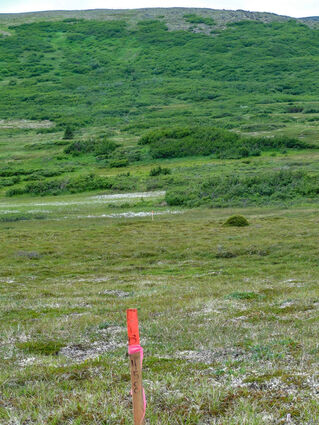Priority copper targets north of Pebble
North of 60 Mining News – January 10, 2020
Last updated 9/26/2020 at 11:39am

Bill Ellis, Alaska Earth Sciences
A geophysics line staked out last summer by Chuchuna Mineral Company at the southern end of the Groundhog copper property.
Quaterra Resources Inc. Jan. 9 reported that a geophysical survey carried out on its Groundhog property in Southwest Alaska has identified 19 porphyry copper-gold targets.
Groundhog is a 54,880-acre property that covers a northern extension of a structural zone that hosts several porphyry targets and deposits, including the world-class Pebble copper-gold-molybdenum deposits about three miles to the south.
Alaska Earth Sciences, an Anchorage-based geological consulting firm, discovered the Groundhog prospect and Kennecott Exploration Inc., a subsidiary of Rio Tinto, explored the property for about five years prior to 2014.
Following Kennecott's departure, Alaska Earth Sciences formed a partnership with Kijik Corp., the Alaska Native village corporation for Nondalton, the nearest community to Groundhog.
This partnership, Chuchuna Mineral Company, set out to find a mining company to continue the exploration of the promising asset.
Quaterra Resources cut a deal with Chuchuna in 2017 that provides the exploration company an option to earn a 90 percent interest in Chuchuna in exchange for US$5 million in exploration over five years and a US$3 million cash payment in the sixth year.
Last fall, a 1,664-line-kilometer z-axis tipper electromagnetic (ZTEM) and magnetic survey was carried out over 165 square miles of the Groundhog property.
Quaterra said a review of the data resulted in the selection of 19 targets that were ranked using ZTEM responses from similar porphyry systems, including the world-class Pebble copper-gold-molybdenum deposit to the south.
Eight top-ranked targets were selected that compare favorably in size and intensity to the ZTEM responses of other mineralized systems in Central and North American mining districts. The remaining 11 target anomalies are less similar to other known deposits.
Quattera said the combined interpretation of all of the geophysical data collected on the Groundhog property to date leads to grouping the ZTEM targets into two areas – the northwest sector, which is associated with a magnetic anomaly known as Alpha, and the southeast sector, an extension of the ZG fault zone area trending northeastward from Pebble.
A limited geologic reconnaissance program of the strongest ZTEM survey targets did not identify any significant geochemical anomalies, due primarily to thick overburden and scarce outcrop.
Previous geologic work – including an induced polarization (IP) geophysical line and a shallow drill hole in 2017 at the Alpha anomaly in the northern part of the ZTEM survey area – has identified areas of strong to pervasive propylitic (porphyry related) alteration, with anomalous copper (0.18 percent), molybdenum (0.01 percent) and gold (0.8 parts per million) basalt/gabbro/pyroxenite.
Quattera said additional IP geophysical surveys and drilling will be required to evaluate these anomalies, but the timing and scope of such programs has yet to be determined.
Chuchuna has expanded its land position based on the ZTEM results.
–SHANE LASLEY




Reader Comments(0)